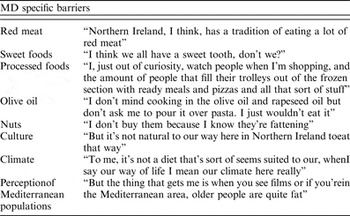There is strong evidence linking consumption of the Mediterranean diet (MD) to a reduced risk of CVD( Reference Estruch, Ros and Salas-Salvadó 1 ) and type II diabetes( Reference Salas-Salvadó, Bull and Babio 2 ), however there is uncertainty about whether non-Mediterranean regions will adopt this dietary pattern. A number of general barriers to dietary change are well documented in the literature( Reference Macdiarmid, Loe and Kyle 3 – Reference de Almeida, Grace and Afonso 6 ), but there is limited information on the specific barriers that may exist in relation to adoption of a MD by Northern European populations. This research aimed to investigate attitudes towards following a MD in individuals at high CVD risk in a Northern European population.
Focus groups (n = 12) were held with the target group and explored awareness of a MD, attitudes towards the key components of a MD and barriers to dietary change towards a MD. Discussions were audio-recorded, transcribed verbatim and data was analysed thematically. Nvivo software was used to manage the coded data.
Sixty-seven high CVD risk adults (60% female, mean age 64 y) took part. Participants were aware of the MD, but knowledge of its composition was limited. Several barriers to consumption of a MD were identified, most of which were similar to barriers associated with general healthy eating, such as cost, availability, eating habits, lack of knowledge, lack of cooking skills and taste. However, further barriers specific to following a MD were identified, including food specific barriers, culture, climate and negative perceptions of the body image of those from the Mediterranean region.

This research indicates that although there was good awareness of the term MD in this Northern European sample at high risk of CVD, knowledge of the specific composition of a MD was limited. In addition to the usual barriers to dietary change, a number of barriers specific to a MD were identified. Interventions to encourage adoption of a MD in non-Mediterranean populations will need to ensure appropriate education and support is provided to address these knowledge gaps and barriers.


